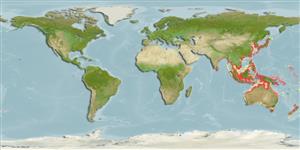Common names from other countries
Classification / Names / Names
Namen | Synonyme | Catalog of Fishes (gen., sp.) | ITIS | CoL | WoRMS
Environment: milieu / climate zone / depth range / distribution range
Ökologie
Benthopelagisch; tiefenbereich 0 - 50 m (Ref. 125642). Tropical, preferred 24°C (Ref. 107945)
Indo-West Pacific.
Length at first maturity / Size / Gewicht / Alter
Maturity: Lm 13.1 range ? - ? cm Max length : 15.9 cm CW Männchen/unbestimmt; (Ref. 125642)
Carapace tough to granulose, regions discernible; front with 3 acutely triangular teeth; 9 teeth on each anterolateral margin, the last tooth much larger than preceding teeth. Larger chela with conical tooth at base of fingers; pollex ridged. Color: carapace dull green to brown.
Minimum depth assumed from its ecology. Shallow waters up to depths of 50 m. Inhabits sandy to sandy-muddy substrates (Ref. 343). Benthopelagic predator, feeding mainly on bivalves (Lamellibranchia), benthic crustaceans, fishes and cephalopods (Ref. 117071).
Members of the order Decapoda are mostly gonochoric. Mating behavior: Precopulatory courtship ritual is common (through olfactory and tactile cues); usually indirect sperm transfer.
Ng, P.K.L. 1998. (Ref. 343)
IUCN Rote Liste Status (Ref. 130435)
CITES Status (Ref. 108899)
Not Evaluated
Not Evaluated
Bedrohung für Menschen
Harmless
Nutzung durch Menschen
Fischereien: kommerziell
FAO - Aquakultur: production; Fischereien: landings, Artbeschreibung | FishSource | Sea Around Us
Tools
Internet Quellen
Estimates based on models
Preferred temperature
(Ref.
115969): 13.8 - 29.1, mean 28 (based on 1586 cells).
Widerstandsfähigkeit
hoch, Verdopplung der Population dauert weniger als 15 Monate. (K=0.44-1.76).
Prior r = 1.19, 95% CL = 0.79 - 1.79, Based on 2 data-limited stock assessments.
Verwundbarkeit
Low vulnerability (10 of 100).
